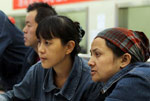ADB cuts 2011 China growth forecast to 9.3%
Updated: 2011-09-14 16:57
(Xinhua)
|
|||||||||||
BEIJING, September 14 (Xinhua) -- The Asian Development Bank (ADB) on Wednesday cut China's growth forecast to 9.3 percent for the year from its previously estimated 9.6 percent.
The ADB also lowered its estimate for the country's economic growth to 9.1 percent from 9.2 percent for next year, according to the update to the Asian Development Outlook released Wednesday by the Manila-based lender.
China's economic growth slowed during the first half of the year, mainly due to the country's tightening policies and weakening outbound demand, said Paul Heytens, ADB country director for China, in the report.
The country's gross domestic product (GDP) rose by 9.5 percent year-on-year in the second quarter of 2011, tapering off from the 9.7-percent growth posted in the first quarter of this year and 9.8 percent in the fourth quarter of last year.
The report said the country's economy will largely be driven by domestic consumption and future investment. Urbanization and the massive construction of government-subsidized housing projects will become important engines for GDP growth.
A possible economic slowdown in the second half is mainly due to the faltering global economic recovery, especially the weak demand from European countries as a result of the deepening debt crisis, according to the report.
Food prices will rise at a slower pace over the rest of the year, partly because of the bumper autumn harvest and increased pork supplies.
Inflationary pressures may ease in the second half and next year, as food prices account for about one-third in the basket of goods used to calculate China's consumer prices.
The country's consumer price index, a main gauge of inflation, rose 6.2 percent in August year-on-year, down from a 37-month high of 6.5 percent in July, according to data from the National Bureau of Statistics.
A slower inflation rate, coupled with reductions in personal income tax and government efforts to improve people's livelihoods, will help to stimulate private consumption, the ADB said.
China has adopted a slew of measures to stem soaring consumer prices by steadily raising interest rates, ordering banks to put more money in reserve and imposing limits on home purchases in several major cities.
The bank said it expects the country to increase investment in construction of government-subsidized housing units, including affordable homes, low-rent homes, public rental homes and price-capped homes.
China plans to build 10 million subsidized housing units this year and 36 million more over the next five years.
Furthermore, the ADB said China has become an aging society since 2000. The country's working-age population will peak in 2015 and labor shortages will become more common thereafter.
A relatively high age-dependency ratio means more medical expenses and endowment expenditures from the government, while labor shortages are likely to push up labor costs. This highlights the pressing need for the country to rebalance its economy and increase labor productivity, the bank noted.













